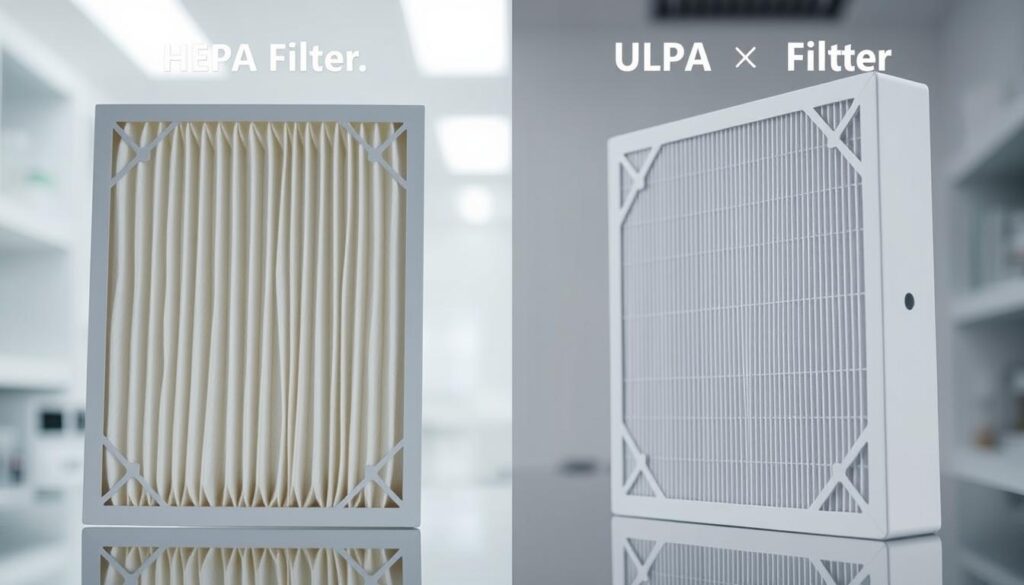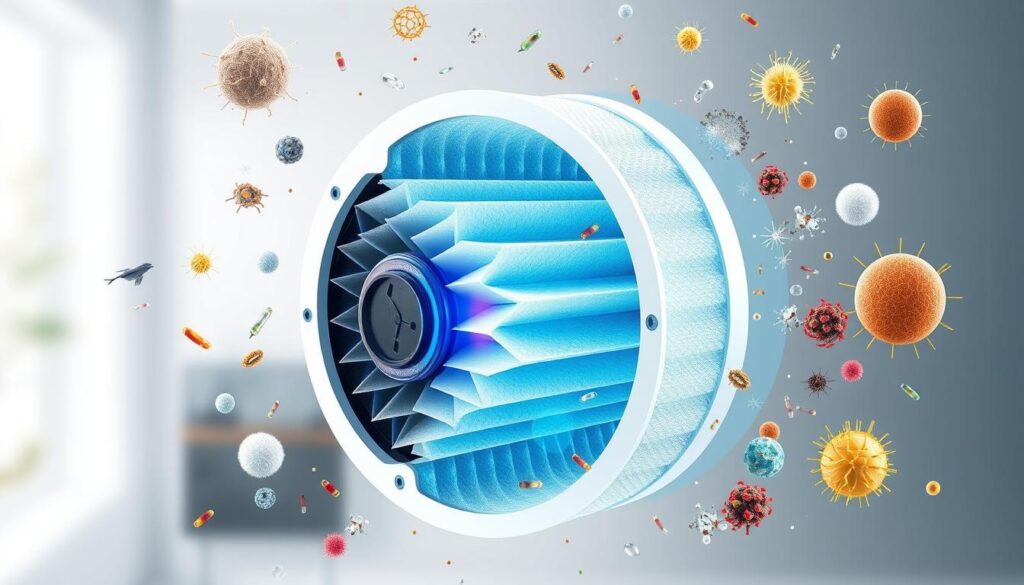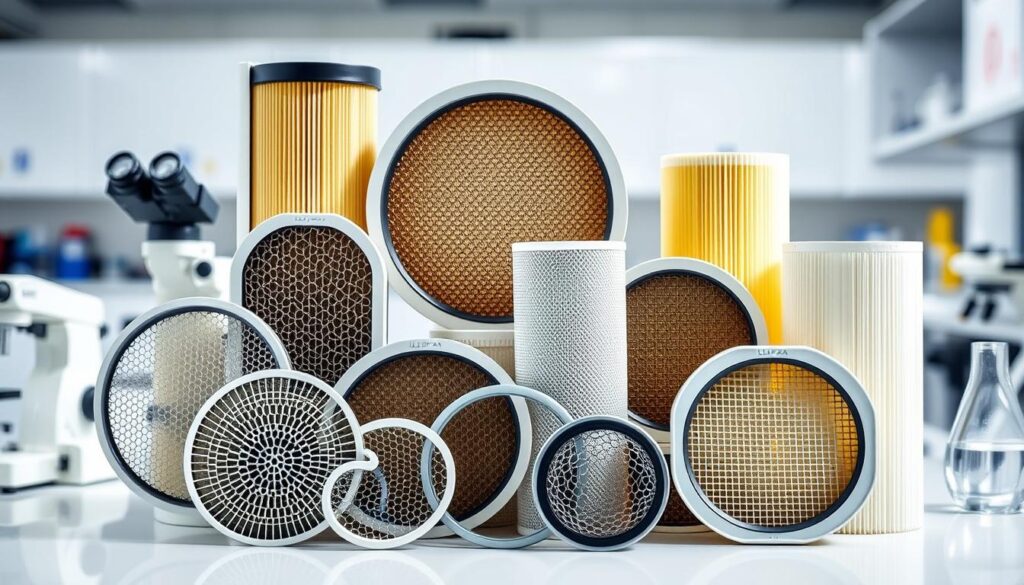
HEPA vs ULPA Filter: Key Differences to Know
Did you know HEPA filters can catch 99.97% of particles 0.3 microns and larger? But ULPA filters go even further. They are 99.999% effective for particles as small as 0.12 microns. This big difference is key when choosing the best air purification for different places.
Knowing how HEPA and ULPA filters work is important. It helps improve air quality and guides your choices for places like hospitals and labs. We’ll explore what makes each filter unique, their effectiveness, and where they’re best used. This will help you make smart choices for keeping the air clean.
Key Takeaways
- HEPA filters are 99.97% effective for 0.3-micron particles.
- ULPA filters achieve 99.999% efficiency for submicron particles.
- ULPA filters allow 20-50% less airflow compared to HEPA filters.
- HEPA filters have a longer lifespan of up to 10 years.
- Costs of ULPA filters are approximately 35% higher than HEPA filters.
Understanding HEPA Filters
HEPA filters, short for High-Efficiency Particulate Air filters, are key in air purification. They catch at least 99.97% of particles that are 0.3 microns or bigger. Their high efficiency ratings make them perfect for many uses, keeping places clean and safe from harmful stuff.
Definition and Efficiency Ratings
HEPA filters are made to catch airborne particles well. They have a top-notch efficiency rating of 99.995% for dust particles 0.3 microns or bigger. This puts them between EPA and ULPA filters in terms of how well they work. Their high filtration skills are key in places where air quality must be very good.
Common Applications of HEPA Filters
HEPA filters are used in many fields because they keep the air clean. They are found in:
- Healthcare places like hospitals and clinics, where keeping infections away is crucial
- Schools and labs, to keep experiments safe and clean
- Home air purifiers, to make indoor air better
- Factories, especially for making electronics and medicines, to cut down on contamination
Advantages of HEPA Filters
Using HEPA filters has many benefits:
- Longevity: They can last up to 10 years, so you don’t have to replace them often.
- Airborne contaminants reduction: They really cut down on allergens, dust, and other small particles.
- Wide application range: They work well in many places, making sure the air is clean.

What are ULPA Filters?
ULPA filters, or Ultra-Low Particulate Air filters, are key in places needing very clean air. They can remove at least 99.999% of particles as small as 0.12 microns. This makes them very important in many industrial settings.
Definition and Efficiency Metrics
ULPA filters are better than traditional HEPA filters. HEPA filters can remove 99.97% of 0.3-micron particles. ULPA filters are mainly used in cleanrooms rated ISO-5 or higher. These places need very high air quality.
Applications of ULPA Filters
ULPA filters are used in many important fields, like:
- Semiconductor manufacturing
- Pharmaceutical production
- Electronics assembly in cleanroom environments
These fields need very clean air to avoid contamination. This is crucial for keeping products safe.
Benefits of Using ULPA Filters
Using ULPA filters has many benefits:
- Superior air quality: They provide a cleaner environment.
- Reduced contamination risk: They lower the chance of airborne contamination.
- Essential in specific environments: They are vital for industries needing high purity.
Even though they cost more than HEPA filters, their strict control of contamination is crucial. This is especially true in sensitive manufacturing areas.

Difference Between HEPA and ULPA Filter
It’s important to know the difference between HEPA and ULPA filters. They are used for different needs. HEPA and ULPA filters have different levels of efficiency and how well they catch particles.
Filtration Efficiency Comparison
HEPA filters can catch 99.995% of airborne particles. ULPA filters do even better, with 99.999% efficiency. This shows a big difference in how well they work, especially in places that need very clean air.
Particle Size Retention of HEPA vs. ULPA
HEPA filters can catch particles as small as 0.3 micrometers. But ULPA filters can catch even smaller particles, down to 0.12 micrometers. This is why ULPA filters are used in places like labs and cleanrooms where air needs to be very clean.
Usage Contexts: When to Use Each Type
Choosing the right filter depends on what you need. HEPA filters are good for places that need a lot of air flow and last longer. ULPA filters are more expensive but catch even more particles, making them perfect for very clean environments.
How HEPA and ULPA Filters Work
HEPA and ULPA filters are amazing at cleaning the air. They use special filtration mechanisms to catch bad stuff while letting good air through. These mechanisms are diffusion, interception, and inertial impaction.
Diffusion happens when tiny particles move wildly due to air molecules. This makes HEPA and ULPA filters great at catching very small particles. HEPA filters, for example, can catch 99.97% of 0.3-micron particles.
Interception catches bigger particles as they hit the filter fibers. ULPA filters are super good at this, catching almost all particles down to 0.12 microns.
Inertial impaction traps bigger particles that can’t follow the air’s curve. This is key for HEPA and ULPA filters to catch big airborne threats.
HEPA and ULPA filters make the air cleaner, especially in places like hospitals. Knowing how they work helps you pick the best one for your needs.
HEPA vs ULPA Particle Filtration
Understanding how HEPA and ULPA filters work helps us see their strengths. These filters are made to catch different types and sizes of airborne particles. They are key in many industries.
Mechanisms of Particle Capture
HEPA and ULPA filters capture particles in different ways because of their design. HEPA filters use fibers to catch particles. They can trap 99.995% of 0.3 µm particles.
ULPA filters, with their denser fibers, can filter even better. They can catch 99.999% of 0.1 µm particles. This makes ULPA filters better at catching very small particles that can be harmful.
Types of Particles Captured by Each Filter
Both HEPA and ULPA filters can catch many airborne particles. But they are better at different things. HEPA filters are great at removing allergens, dust, and mold spores. They are often used in homes and hospitals.
ULPA filters, however, are better at catching viruses and smoke. They are perfect for cleanrooms and labs. Companies in biotech, pharma, and semiconductors use them to keep their spaces clean and safe.
HEPA vs ULPA Air Purification
Understanding HEPA and ULPA filters is key for air purification. Your choice affects how much clean air a system can deliver. These filters vary in efficiency and how they handle airflow.
Airflow and Pressure Drop Considerations
HEPA and ULPA filters differ in airflow management. HEPA filters let more air pass through than ULPA filters. HEPA filters catch 99.995% of particles over 0.3 microns, while ULPA filters catch 99.999% of particles as small as 0.1 microns.
ULPA filters, however, block more airflow. This means they cause a bigger drop in air pressure. Choosing the right filter is important to keep air quality high.
Air Change Rates in Different Systems
In homes, HEPA filters are often better because they balance filtration and airflow. But, ULPA filters are used in places like cleanrooms in the electronics industry. They need to catch very small particles.
Knowing about airflow and choosing the right filter is crucial. It makes air purification more effective.
HEPA vs ULPA Specifications
It’s important to know the differences between HEPA and ULPA filters. This helps you pick the best air filtration system for your needs. We’ll look at ISO class ratings, lifespan, and how often you need to maintain them.
Comparing ISO Class Ratings
ISO class ratings show how well a filter cleans the air. ULPA filters are more effective than HEPA filters. Here’s what you need to know:
| Filter Type | ISO Class Rating | Particle Size Efficiency |
|---|---|---|
| HEPA | ISO Class 5 | Removes 99.97% of particles ≥ 0.3 microns |
| ULPA | ISO Class 3 | Removes 99.999% of particles ≥ 0.1 – 0.2 microns |
ULPA filters clean the air better, making them perfect for places that need to be very clean.
Lifespan and Maintenance Needs
HEPA and ULPA filters last different lengths of time. This affects how often you need to replace them. Here’s what you should know:
- HEPA filters last longer, saving you money on replacements.
- ULPA filters filter finer particles but might reduce airflow by 20% to 50% compared to HEPA filters.
- ULPA filters cost more upfront, which you should consider when budgeting for air filtration.
When deciding between HEPA and ULPA filters, think about your space’s airflow and cleanliness needs. This will help you choose the right filter for you.
Choosing the Right Filter for Your Needs
Choosing the right filter means knowing what you need. When picking between HEPA and ULPA filters, think about airflow, particle size, and standards.
Factors to Consider for Your Application
It’s important to know where the filter will go. Here are some key things to think about:
- Airflow Requirements: ULPA filters might block airflow more than HEPA filters. This is a big deal for homes that need good air flow.
- Efficiency Ratings: HEPA filters catch 99.99% of particles under 0.3 microns. ULPA filters catch 99.9995% of particles under 0.12 microns. The size of particles matters here.
- Application Types: Think about where the filter will be used. HEPA filters work well in homes. ULPA filters are key in places like clean rooms in factories.
- MERV Ratings: Filters have different ratings, from MERV 8 to MERV 13. Make sure the MERV rating fits your air quality needs.
Regulatory and Containment Standards
Following industry standards is a must in some cases. HEPA filters meet ISO Class 5 standards. ULPA filters meet ISO Class 3 standards. These are important in places that need very clean air.
Rules and regulations might also decide what filter you need. This is especially true in fields like medicine and electronics.
Cost Considerations: HEPA vs. ULPA
Choosing between HEPA and ULPA filters involves looking at costs. Both filters have different prices for buying and keeping up. Knowing these costs helps decide which one fits your budget for clean air.
Initial Costs of Filters
HEPA filters are usually cheaper than ULPA filters. This is because they are made with simpler processes and need less material. ULPA filters, however, cost about 35% more. They are pricier because they catch even smaller particles, making them better for certain jobs.
Long-term Maintenance and Replacement Costs
Thinking about long-term costs is key. HEPA filters last about 10 years, while ULPA filters last 5 to 8 years. This means HEPA filters need to be replaced less often. But, ULPA filters can make systems work harder, which might increase energy costs.
So, weighing the costs of HEPA vs ULPA filters is important. Your needs and how you use the filters will help you choose the best one.
Conclusion
HEPA and ULPA filters are both key in different areas. HEPA filters catch 99.97% of particles 0.3 microns or bigger. They’re great for homes, offices, and many medical places.
They’re used a lot in hospitals, labs, and HVAC systems. This shows how well they work in keeping air clean.
ULPA filters, however, go further, catching 99.999% of particles as small as 0.12 microns. They’re vital in places like chip making and biotech. They cost more and block air more, but they’re worth it for top air quality.
So, picking the right filter depends on your needs. HEPA filters are often the best for many places. But ULPA filters are key for very sensitive areas.
By thinking about what you need, you can pick the best filter. This keeps everyone healthy and products safe in your space.
FAQ
What is the main difference between HEPA and ULPA filters?
HEPA filters catch at least 99.97% of particles 0.3 microns or larger. ULPA filters, however, remove at least 99.999% of particles as small as 0.12 microns.
In what applications are HEPA filters commonly used?
You’ll find HEPA filters in healthcare, cleanrooms, and home air purifiers. They’re great at cutting down airborne pollutants.
What are the benefits of using ULPA filters?
ULPA filters offer top-notch air quality and lower contamination risks. They’re key in places like pharmaceuticals and clean manufacturing where purity is paramount.
How do HEPA and ULPA filters capture particles?
Both use diffusion, interception, and inertial impaction to catch particles. This makes them effective at trapping various sizes of particles.
What are the pressure drop considerations for HEPA and ULPA filters?
ULPA filters have a higher pressure drop than HEPA filters. This can slow down airflow and affect air change rates in systems.
What ISO Class ratings apply to HEPA and ULPA filters?
HEPA filters usually have ISO Class 5 ratings. ULPA filters, on the other hand, have ISO Class 3 ratings, offering better standards.
How long do HEPA filters last compared to ULPA filters?
HEPA filters can last up to ten years. ULPA filters, however, typically last between five to eight years, depending on use and maintenance.
What should I consider when choosing between HEPA and ULPA filters?
Think about airflow needs, particle size, regulatory standards, and your environment’s specific requirements.
Are ULPA filters more expensive than HEPA filters?
Yes, ULPA filters are about 35% pricier than HEPA filters. But, long-term costs can differ based on usage and lifespan.
How can HEPA and ULPA filters impact air purification?
Their effectiveness greatly affects air quality. ULPA filters are better at filtering smaller particles but might affect airflow more than HEPA filters.
